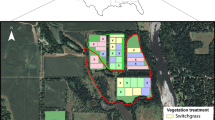Summary
Plant populations of Schizachyrium scoparium var. frequens with a history of long-term grazing by domestic herbivores were characterized by shorter and narrower leaf blades and tillers of lower weight than plants from populations with a history of no grazing. Following four biweekly defoliation events plants from the grazed populations additionally displayed lower specific leaf weights, lower amounts of biomass removed per tiller upon defoliation and a greater number of new and regrowing tillers. Production values per plant remained similar between the two populations because of a greater number of tillers per plant in the grazed population.
A large amount of allozymic polymorphism was observed in both the grazed and non-grazed populations. Results of the electrophoretic analyses indicated that a minimum of 66% of the plants sampled represented separate genotypes. No distinction could be made between grazed and non-grazed populations in terms of allozymic partitioning. The morphological variation observed between these two populations may represent a shift in the relative dominance of a series of genotypes variously adapted to herbivory.
Similar content being viewed by others
References
Aldous AE (1934) Effect of burning on Kansas bluestem pastures. Kans Agric Exp Sta, Tech Bul 38
Archer S, Tieszen LL (1983) Effects of simulated grazing on foliage and root production and biomass allocation in an Arctic tundra sedge (Eriophorum vaginatum). Oecologia (Berlin) 58:92–102
Bradshaw AD (1959) Population differentiation in Agrostis tenuis Sibth. I. Morphological differentiation. New Phytol 58:208–227
Branson FA (1953) Two new factors affecting resistance of grasses to grazing. J Range Manage 6:165–171
Caldwell MM, Richards JH, Johnson DA, Nowak RS, Dzurec RS (1981) Coping with herbivory: photosynthetic capacity and resource allocation in two semiarid Agropyron bunchgrasses. Oecologia (Berlin) 50:14–24
Cardy BT, Stuber CW, Goodman MM (1980) Techniques for starch gel electrophoresis of enzymes from maize (Zea mays L.). Inst Stat Mimeograph Ser No 1317, N Car St Univ, Raleigh, North Carolina
Carman JG (1982) Defoliation responses of little bluestem at the organism and population level. Dissertation, Texas A & M Univ, College Station
Carman JG Morphological characterization and defoliation responses of selected Schizachyrium scoparium genotypes. Am Midl Nat (In press)
Cooprider KB (1977) An archeological inventory of the Fort Riley Military Reservation. Kans State Hist Soc, Topeka, Kans
Cooprider KB (1979) An archeological inventory of the training areas: Fort Riley Military Reservation. Kans State Hist Soc, Topeka, Kans
Detling JK, Painter DL (1983) Defoliation responses of western wheatgrass populations with diverse histories of prairie dog grazing. Oecologia (Berlin) 57:65–71
Detling JK, Coppock DL, Painter EL (1984) Comparative physiological ecology of populations of several North American grass species with different grazing histories. Bull Ecol Soc Am 65:196
Gray AJ, Scott R (1980) A genecological study of Puccinellia maritima Huds (Parl). I Variation estimated from single-plant samples from British populations. New Phytol 85:89–107
Gregor JW, Sansome FW (1927) Experiments on the genetics of wild populations. Part I Grasses. J Genet 17:349–364
Harberd DJ (1967) Observations on natural clones in Holcus mollis. New Phytol 60:401–408
Hickey WC Jr (1961) Growth form of crested wheatgrass as affected by site and grazing. Ecology 42:173–176
Kahler AL, Allard RW, Krzahowa M, Wehrhahn CR, Nevo E (1980) Associations between isozyme phenotypes and environment in the slender wild oat (Avena barbata) in Israel. Theor Appl Genet 56:31–47
Kemp WB (1937) Natural selection within plant species as exemplified in a permanent pasture. J Hert 28:329–333
Mahmoud A, Grime JP, Furness SB (1975) Polymorphism in Arrhenatherum elatius (L) Beauv ex J & C Presl. New Phytol 75:269–276
McNaughton SJ, Wallace LL, Coughenour MB (1983) Plant adaptation in an ecosystem context: Effects of defoliation, nitrogen and water on regrowth of an African C4 sedge. Ecology 64:307–318
McNeilly T (1981) Ecotypic differentation in Poa annua: Interpopulation differences in response to competition and cutting. New Phytol 88:539–547
Peterson RA (1962) Factors affecting resistance to heavy grazing in needle-and-thread grass. J Range Manage 15:183–189
Quinn JA, Miller RV (1967) A biotic selection study utilizing Muhlenbergia montana. Bull Torrey Bot Club 94:423–432
Stapledon RG (1928) Cocksfoot grass (Dactylis glomerata L) ecotypes in relation to the biotic factor. J Ecol 16:71–104
Warwick SI, Briggs D (1978) The genecology of lawn weeds. II Evidence for disruptive selection in Poa annua L in a mosaic environment of bowling green lawns and flower beds. New Phytol 81:725–737
Westoby M (1980) Relations between genet and tiller population dynamics; survival of Phalaris tuberosa tillers after clipping. J Ecol 68:863–869
Author information
Authors and Affiliations
Rights and permissions
About this article
Cite this article
Carman, J.G., Briske, D.D. Morphologic and allozymic variation between long-term grazed and non-grazed populations of the bunchgrass Schizachyrium scoparium var. frequens . Oecologia 66, 332–337 (1985). https://doi.org/10.1007/BF00378294
Received:
Issue Date:
DOI: https://doi.org/10.1007/BF00378294




